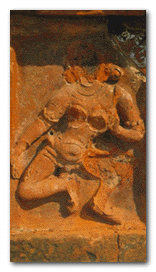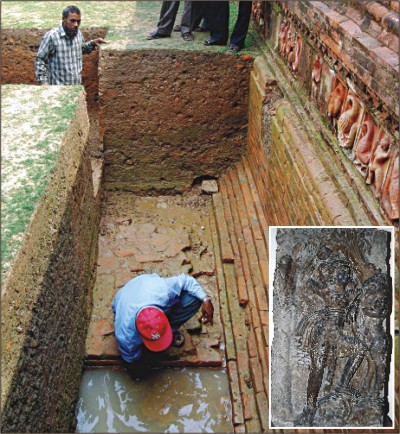 Evidence
of the rise of Mahayana Buddhism in Bengal from the 7th century onwards,
Somapura Mahavira, or the Great Monastery, was a renowned intellectual
centre until the 12th century. Its layout perfectly adapted to its religious
function, this monastery-city represents a unique artistic achievement. With
its simple, harmonious lines and its profusion of carved decoration, it
influenced Buddhist architecture as far away as Cambodia.
Evidence
of the rise of Mahayana Buddhism in Bengal from the 7th century onwards,
Somapura Mahavira, or the Great Monastery, was a renowned intellectual
centre until the 12th century. Its layout perfectly adapted to its religious
function, this monastery-city represents a unique artistic achievement. With
its simple, harmonious lines and its profusion of carved decoration, it
influenced Buddhist architecture as far away as Cambodia.
By far the most spectacular Buddhist site to be discovered is the
gigantic temple and monastery of Paharpur, dating from the eighth century
A.D. Paharpur is about 35 miles (56 km) northwest of Mahasthan via the busy
market town of Jaipurhat. Access from Jaipurhat is along a rutted cart track
that is sometimes passable in an ordinary car. Paharpur has been identified
from a series of inscribed clay seals as the Somapura Vihara from the great
Pala Dynasty. It is the biggest single vihara (image house) south of the
Himalayas, measuring approximately 900 feet (273 meters) along each side and
enclosed by an outer wall with 177 monastic cells built into it. In the
center of the 22-acre (nine-hectare) courtyard are the ruins of a mighty
temple which rises to a height of 72 feet (22 meters)- an unusual hillock
giving the local village of Paharpur its name (pahar meaning 'hill'). The
temple is cruciform in plan, built in high quality brick with thousands of
terra-cotta plaques depicting the art form of that period, whether it be
religious or secular, human or animal, mythological or purely an artist's
whim .
During recent exploratory excavations, an important archaeological find of a
large bronze Buddha dating from the Gupta period was accidentally discovered
in one of the monks cells. It is considered to be one of the most splendid
specimens of mature Pala art of the ninth century, cast using the 'wax loss'
process. Paharpur's later history is uncertain but it seems to have been
abandoned in the 12th century A.D., probably due to flooding. Today the site
is under water during the monsoon.

Archaeology Department Director Dr Md Shafiqul Alam confirmed the recent finds, saying the brick-built structures were found under the foundation of the main temple at Paharpur. He said another structure was found outside the temple area. "These structures confirm that there was a civilization before the Pala Dynasty," he said.
Mahbubul Alam, assistant custodian of Paharpur site, said an ancient broken terracotta piece was found under the basement of the temple near the newly discovered structure while a decorated brick was found in the lower portion of the northern side of the temple. Meanwhile, archaeologists dug out another brick-built structure from an earth-filled base on top of the 72-feet high temple. They believe the structure was made for beautification.
Nahid Sultana, custodian of Rabindra Kacharibari Site of Shajadpur in Sirajganj and a member of the Paharpur excavation team, said an almost similar brick-built wall was found outside the temple premises. Both the structures were built with bigger size bricks. According to archaeological documents, at least 53 stone statues have been lying in the wall niches in the lower portion of the temple underground. Thirteen statues have so far been found during several archaeological excavations, according to officials ( Daily Star, March 15, 2008).